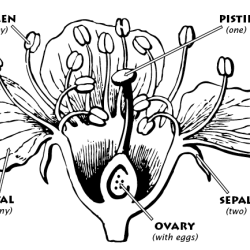Source Institutions
Source Institutions
Add to list Go to activity
Activity link broken? See if it's at the internet archive

In this activity (on pages 9-14), learners dissect a real flower -- the kind of work botanists do. Learners discover where to find pollen, and learn about other flower parts including petals, pistil, and stamen. In the "What We Know" section at the beginning, learners are introduced to exactly what pollen is and why flowers need it. This could be a great activity for allergy season!
- 5 to 10 minutes
- 45 to 60 minutes
- $1 - $5 per group of students
- Ages 8 - 14
- Activity, Experiment/Lab Activity
- English
Quick Guide
Materials List (per group of students)
- 1 dissecting needle
- 1 magnifying lens
- 1 fresh flower (lily flowers work best; florists sometimes will donate day-old flowers)
- 1 roll of clear tape
- 1 piece of cardboard or thick paper
Subjects
-
Life Sciences
-
Diversity of Life
- Plants
-
Diversity of Life
-
The Nature of Science
-
The Scientific Process
- Conducting Investigations
-
The Scientific Process
Informal Categories
- Gardening
- Nature and Environment
Audience
To use this activity, learners need to:
- see
- touch
Learning styles supported:
- Involves teamwork and communication skills
- Involves hands-on or lab activities
Designed specifically for
- Rural dweller
Culture, ethnicity, and gender
-
Girls
- Explicity developed for this group
Other
Foreign language versions of this resource:
Components that are part of this resource:
Includes alignment to state and/or national standards:
This resource is part of:
Access Rights:
- Free access
By:
Source Collection
- Science After School Consumer's Guide
Rights:
- All rights reserved, University of Nebraska State Museum and Nebraska 4-H, 2001
Funding Sources:
- NSF Informal Science Education Program, 9909496
- Howard Hughes Medical Institute
